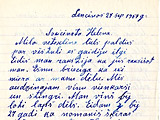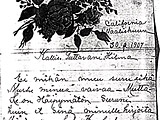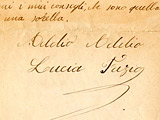Services
The immigrants' story, told through letters
by Madeleine Baran, Minnesota Public RadioIn the spring of 1925, a letter made the trip from a small town in eastern Ohio to a convent in Italy, where a teenage girl opened it and learned that her mother had died.
Listen to the Letters



"All is quiet like the tomb of that sweet pure soul; celestial creature," her father Diego Delfino wrote in a letter that's now part of a University of Minnesota online pilot project to publish correspondence between non-English speaking immigrants and those they left behind.
Some of the letters contain simple requests for items like nylon stockings, sugar, or money. Many writers express deep emotions - longing, jealousy, loneliness or, like Delfino, grief.
"My heart is closed, locked in a tight veil, from which that sweet softness of one time is inhibited from transpiring;" he confided to his daughter Mary Helen. "[I]t no longer has those beats of joy. It's dry. I cannot say more, beyond these words, about this painful story. It tears at my throat."
Many of the letters had been stored for years in archives, but staff didn't have the time to sort through hundreds of boxes to find and catalogue them, and didn't have the money or the technology to scan and post the aging documents online.
The organizers of "A Heart Connects Us: Immigrant Letters and the Experience of Migration" hope the project will lead to a richer understanding of the emotional impact of immigration and spur new efforts to collect immigrant letters.
Within the next few months, the project's organizers will begin an ambitious effort to match letters scattered in archives around the world, uniting letters between mothers and sons, husbands and wives, and brothers and sisters. For now, the project's site displays 40 letters written by eight immigrants and their families from 1850 to 1970.
"It's the story that really appeals, not just to scholars, but to just people surfing the web and people interested in family histories or in local communities," said Donna Gabaccia, director of the University's Immigration History Research Center, the organization overseeing the project.
Scholars also hope that connecting letters written by immigrants and those they left behind will enrich historians' understanding of the ways previous generations coped with long periods of separation without the benefit of emails and phone calls.
The letters written by Diego Delfino, the immigrant who lost his wife, convey a deep sense of longing for the daughter he left behind.
"I watch over you, and think of you constantly, and I wish I could be very close to your sighs," he wrote.
But the letters also hint at more complicated troubles. Delfino had fallen behind in payments to the convent where his daughter was living. He wrote that he feared for his life, but provided few details.
"Concerning your nightmare, in which two killers wanted to stab me to death, and you protected me by plunging in front of me, therefore saving your life and sacrificing yours, well, there is nothing to be surprised about," he wrote. "I'm expecting a new attempt on my life, cowardly premeditated, by the hoodlums, but so far no one is coming."
Forty-two days later, Delfino was murdered. Police never found his killer.
Gabaccia acknowledges it's impossible to know whether the letters found in archives are representative of the broader immigrant experience. Middle-class people preserved more letters than farmers or working-class people, she said.
Also, some people broke off all ties with family members once they immigrated across the Atlantic. Others quarreled over money and relationships gone sour.
"Silences disrupted relationships, are difficult to deal with, and those are not the ones that are generally preserved," said Sonia Cancian, one of the scholars leading the project.
Many immigrants and those they left behind were illiterate, adding yet another complication for historians seeking to interpret the writings. Some dictated their letters to a more educated friend. Others wrote in a formulaic style, likely copied directly from other letters they had seen.
Despite these limitations, Cancian said she's struck by the intensity of emotion conveyed in the letters that have been preserved. Of the thousands of letters she's pored over, the ones she finds most striking are the exchanges between the journalist, poet, and anarchist Alessandro Sisca and his wife, whose troubled relationship is documented in a series of letters.
"I would have blown my brains out before telling you that I love you," his wife, Lucia Fazio, wrote in 1898. "I curse the day that you arrived to Boston. I curse the day that I learned to trust."
Cancian said she had an immediate and powerful reaction to the correspondence.
"I thought, 'My goodness! Where is all this coming from? Why all this drama?'"
Despite the compelling nature of many of the letters, scholars said that digitizing decades-old correspondence poses unique challenges. Copyright laws differ from country to country, Cancian said, and the laws are particularly complicated regarding letters written by non-public figures.
For this project, the Immigration History Research Center asked donors for permission to put the letters online, although they had no legal obligation to do so because the letters had already been donated to a public archive.
Gabaccia said that because the project is so unique, she wanted to see whether donors would bring forward any concerns.
"We were extra cautious in proceeding," she said. One family decided not to allow their donated letters to be posted online. The letters chronicled "an illicit love affair," Gabaccia said.
"Everybody involved is dead, but they just felt uncomfortable with making it public on the web," she said.
Gabaccia said the project's goal is not to match or digitize every letter. Most archives simply cannot afford it, and even if they could, she said, it wouldn't be worth the cost, given that relatively few people would access them. Instead, archivists plan to post a sampling of letters online, and also provide better catalogues to prepare historians before they travel to remote archives in places like the Ukraine.
Cancian said that despite her excitement about the digitization project, she hopes that scholars will continue to use traditional archives as well.
"When we go to the archives, it becomes very important to feel the document," she said. "That physicality still means something."
In The Spotlight
-
The Current Music Blog
Your daily note for good music, news and pop culture. With attempted jokes.


